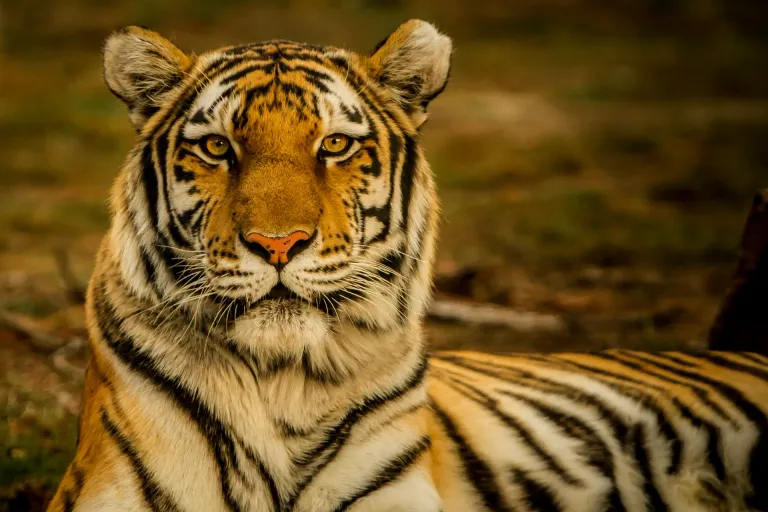(ENG/ESP) bengal tigers/tigres de bengala
The Bengal tiger (Panthera tigris tigris), also known as the royal Bengal tiger or Indian tiger, is a subspecies of tiger that lives in India, Nepal, Bangladesh, Bhutan, Burma and Tibet. It is the most numerous and well-known subspecies of tiger, and is found in a wide variety of habitats, including tropical and subtropical savannahs and forests. Their fur is generally orange or fawn in color. There is a genetic mutation that causes the tiger's orange skin to be replaced by white; These tigers are known as white tigers. An even rarer mutation (of which there are less than one hundred specimens, all in captivity), is known as the golden tiger. The tiger is a national animal in India and Bangladesh.
In 2017, a team of researchers from the IUCN published a new taxonomic classification of the Felidae family in which it only recognized two subspecies of tigers, the continental Asian tiger (Panthera tigris tigris), which includes the Bengal, Siberian, Indochina, South China, and Malay tigers, as well as the extinct Caspian tiger and the Sunda tigers (Panthera tigris sondaica). which groups the Sumatran tiger as well as the now extinct Javan and Bali tigers. This assessment is based on an extensive review of recent publications on tiger morphology and phylogeography.
It was previously considered the second largest subspecies, behind the Siberian tiger (P. tigris altaica). However, recent studies suggest that currently this could be the largest subspecies.3 The total length of males is 270-310 cm, while that of females is 240-265 cm; the tail is about 85-100 cm long and the height at the shoulders is 90-110 cm.4 Weight depends on the region; some tigers are below 100 kg while others reach 230 kg in the case of males.56 In Chitwal seven male tigers shed an average of 221 kg.73 However, those males that live in Central India have a weight between 160 to 233 kg, and an average of 190 kg for males and 131 kg for females.Even Thus, a large male from Ranthambore National Park was discovered, named Ustad (T24), who is responsible for the deaths of four people between 2010 and 2015, weighing up to 250 kg.
The heaviest Bengal tiger, confirmed in hunting records, was a 258.6 kg male, hunted in northern India in 1938. However, the heaviest males, recorded by scientists so far, are two tigers (M105 and M026) weighing more than 270 kg, captured in Nepal, in 1980 and 1984, respectively. The largest Bengal tiger, measured among curves, was a male hunted by Archibald Dunbar Brander, which reached 221 cm in head-body length, with a chest circumference of 150 cm, a height at the shoulders of 109 cm and a tail of only 81 cm, probably severed by a rival male. Although this specimen could not be weighed, it was calculated that its body mass would not be less than 272 kg.
According to Guinness World Records, the largest known Bengal tiger was a large male hunted in 1967; It measured 322 cm in total length in a straight line (338 cm between the curves of the back) and weighed 388.7 kg. Although this is not considered a scientifically correct weight since its measurements do not match its weight and in the photos the tiger is not large, so it is very possible that its real weight is much lower, the specimen was hunted in northern India by David Hasinger, an industrialist from Philadelphia. Currently[when?] this specimen is exhibited at the Smithsonian Institution, in the Mammal Hall.12 At the beginning of the 20th century, male specimens were reported that reached 360 cm in total length; However, there is no scientific corroboration of such sizes and it is most likely that they were measured on the curves of the spine.14
El tigre de Bengala (Panthera tigris tigris), también conocido como tigre de Bengala real o tigre indio, es una subespecie de tigre que habita en la India, Nepal, Bangladés, Bután, Birmania y Tíbet. Es la subespecie más numerosa y conocida de tigre, y se encuentra en una gran variedad de hábitats, incluyendo sabanas y bosques tropicales y subtropicales. Su pelaje es generalmente de color naranja o leonado. Existe una mutación genética que produce que la piel naranja del tigre sea sustituida por el color blanco; a estos tigres se les conoce como tigres blancos. Una mutación aún más rara (de la que existen menos de cien ejemplares, todos en cautiverio), se conoce como tigre dorado. El tigre es un animal nacional en la India y Bangladés.
En 2017 un equipo de investigadores pertenecientes a la UICN publicó una nueva clasificación taxonómica de la familia felidae en la que solo reconocía dos subespecies de tigres, el tigre de Asia continental (Panthera tigris tigris), que agrupa al tigre de Bengala, siberiano, de Indochina, sur de China, malayo, así como el tigre extinto del Caspio y los tigres de la Sonda (Panthera tigris sondaica) que agrupa al tigre de Sumatra así como a los ya desaparecidos tigres de Java y Bali. Esta evaluación se basa en una extensa revisión de publicaciones recientes sobre la morfología del tigre y su filogeografía.
Anteriormente se le consideraba la segunda subespecie en tamaño, detrás del tigre siberiano (P. tigris altaica). Sin embargo estudios recientes sugieren que en la actualidad esta podría ser la subespecie de mayor tamaño.3 La longitud total de los machos es de 270-310 cm, mientras que la de las hembras es de 240-265 cm; la cola mide unos 85-100 cm de largo y la altura a los hombros es de 90-110 cm.4 El peso depende de la región; algunos tigres están por debajo de los 100 kg mientras que otros llegan a los 230 kg en el caso de los machos.56 En Chitwal siete tigres macho arrojaron un promedio de 221 kg.73 Sin embargo, aquellos machos que habitan el Centro de India, tienen un peso de entre 160 a 233 kg, y un promedio de 190 kg para los machos y de 131 kg para las hembras.8 Aun así, se conoció un gran macho del parque nacional Ranthambore, de nombre Ustad (T24), al que se le adjudica la muerte de cuatro personas entre 2010 y 2015, que llegó a los 250 kg de peso.
El tigre de Bengala más pesado, confirmado en los récords de caza, fue un macho de 258.6 kg, cazado al norte de India en 1938.10 Sin embargo los machos más pesados, registrados por científicos hasta ahora, son dos tigres (M105 y M026) de más de 270 kg, capturados en Nepal, en 1980 y 1984, respectivamente.11 El tigre de Bengala más grande, medido entre las curvas, fue un macho cazado por Archibald Dunbar Brander, que alcanzó los 221 cm de longitud cabeza-cuerpo, con una circunferencia de pecho de 150 cm, una altura a los hombros de 109 cm y una cola de tan solo 81 cm, probablemente cercenada por un macho rival. Si bien este ejemplar no pudo ser pesado, se calculó que su masa corporal no sería menor de los 272 kg.
Según los Récords Mundiales Guinness, el tigre de Bengala de mayor tamaño conocido fue un gran macho cazado en 1967; midió 322 cm de largo total en línea recta (338 cm entre las curvas del lomo) y pesó 388.7 kg. Aunque esto no se considera un peso científicamente correcto dado que sus medidas no coinciden con su peso y en las fotos el tigre no goza de gran tamaño, así que es muy posible que su peso real sea mucho más bajo, el ejemplar fue cazado al norte de India por David Hasinger, un industrial de Filadelfia. Actualmente[] este ejemplar se encuentra exhibido en el Instituto Smithsoniano, en el salón de los Mamíferos.13 A principios del siglo XX se reportaron ejemplares machos que alcanzaron los 360 cm de longitud total; sin embargo no existe corroboración científica de tales tamaños y lo más probable es que fueran medidos sobre las curvas del lomo.



